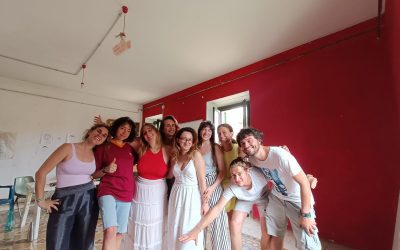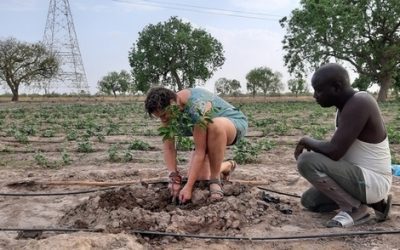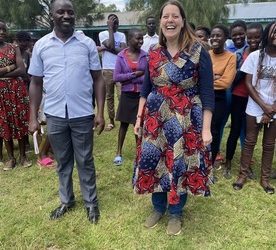Poverty and social justice
Dust under the carpet
The project took place in:
India
Other SCI experience
Written by Lorraine Charbonnier and Barbara Casas Barrachina from Spain, Catalunya
Delhi is the world’s second most populous megacity after Tokyo. Coming from much smaller European cities (Torino and Barcelona), we have been amazed day after day by all the diverse ingredients of Delhi, thousands of cars, people, cows, dogs, trash, smells, shops, street food, rickshaws, etc. The only thing that was missing in our eyes were signs of some kind of social and political activism. After almost one month in Delhi, indeed, the only place where we could find any trace was inside the campus of Jawaharlal Nehru University (JNU). JNU is known for its high political groups and student unions activity. Walking through the campus you feel you are in a hot spot of political activity. Posters, graffities, protests advertisements, discussions, conferences on many topics, social conflicts are discussed there.
We were super excited when we were invited on the 9th of August to a solidarity protest in Jantar Mantar, near CP, the very center of the city. Going out of the metro in Rajiv Chowk we moved to the Jantar Mantar monument, where we were supposed to meet with the protest. As Europeans we were looking for a group people with signs in an open public space, showing their posters and involving the people who was walking by. We didn’t have any idea of what Jantar Mantar was, and why the protest was taking place there. We arrived to the monument but we didn’t see any protest, we walked following the fence of the park of the monument until we found a barricade of police fences and a hundred of police and army officers. Crossing this barrier we reached our place, Jantar Mantar protest venue. The first stands had hindi slogans written in their posters. There was a stage where, mostly man, were making speeches. We walked forward and we could see some other stands, and then we found a group of women and men singing, in their stand there were images of a woman, Irom Sharmila, and slogans for her support.

We found our protest. Feminist collectives had gathered there to show solidarity to the struggle of Irom Sharmila. Also known as the Iron Lady, she had been 15 years in a hunger strike for AFSPA (Armed Forces Special Powers Act) to be repealed. In the leaflet they were spreading says: “Experts argue that the Act perpetuates violation of fundamental democratic rights. It grants excessive powers, and impunity, to armed forces. Atrocities against ordinary citizens have been documented over the years.” The day before she put an end to the strike in order to move forward. “Today, Irom Sharmila makes a move towards freedom, by giving up her fast, which has lasted nearly 16 years. We feel deep respect for Irom Sharmila’s non-violent struggle and her indomitable spirit, and support her decision to give up the fast. The struggle for peace and justice will continue.”
We met with Raju (fake name), our contact who invited us. He told us that they had been there for 3 hours when we arrived, and that the protest would continue for 1 hour more, singing and showing solidarity to the Iron Woman of Manipur. Was that along with that protest there were dozens of stands implementing their own protests. There you could find a group protesting for the rights of Dalits, and in front of them a group protesting to maintain Cast System.
This is Jantar Mantar: a space designated by the government in 1993 as the only official venue to stage protest in the city, where people come from around India to speak up, so the parliament can take their requests and discuss them. Raju explained that it is a place for civil society of India to express their demands to the government. The perplexity was visible in our faces. According to his words, “this is the only space in Delhi where it is allowed to protest, provided that you get the permit. You cannot organize something outside, the only way to do that is to march from the metro station to the venue, and in that case you need to get 5 different permits from 5 different authorities, in which case, you will find a lot of troubles to get them. The last time there was a protest outside of Jantar Mantar, it ended up with water cannons and few protesters arrested. People are afraid to go out of Jantar Mantar.” While we were talking, there was a group of around 100 people, demonstrating with Indian flags and shouting their slogans through the venue. Once they reached the fences of the entrance they stopped the rally and walked back to their stand.
We were there for a while, some police officers approached the Iron Sharmila’s solidarity protest. One of the protesters suggested us to leave before some of us was arrested. We didn’t perceive any threat, but we took his advice and left. Going out Jantar Mantar we had to cross again the barricade of police and army officers, which in the meantime had increased their number.
All in all, after this experience, something changed in our minds. As we focused our research project solely on gender issues, we were ready to deal with extreme inequalities and rigid mind-sets. What we did not expect was a context in which even advocating for social justice is that difficult and risky.
As Raju told us the day after, eventually nothing happened and the protest went on peacefully: no one was arrested. However, especially after the incidents in JNU last February, activists are more afraid of repression even during peaceful protests and the subsequent repercussions. The mechanisms of repression reach their minds. As August Boal (1990) says: “the cops are in their heads, but the headquarters of these cops are in the external reality. […] They have internalized their oppressions”. As if the psychological barriers were not enough, the specific case of Jantar Mantar entails also some physical ones.

Jantar Mantar venue is isolated from the everyday life of the city, which means that people cannot spread their ideas and reasons to others, so the protest remains closed in itself. Moreover, it is also isolated from the political life of the country. The protests which take place there are unlikely to reach the attention of decision makers. So that the demands can hardly be discussed, leave alone implemented.
Before 1993 the protests used to take place in another venue, “just a step away from the Prime Minister’s Office as well as from the Finance, External Affairs and Home Ministries. So, it was extremely unsafe to allow any such activity there. Also, it used to severely affect the cleanliness of the area, which is of national and international importance”, a senior Government official said1. In fact, places around those national institutions and India Gate seem to be part of a completely different city, fewer cars, people, rickshaws, no cows, dogs, trash, smells, shops, street food, etc.
However in our opinion, the real reason to shift the protest venue might be more subtle than that. To force social movements and peaceful protests in an isolated place creates a gap between them and the everyday life of the city and political life of the country. Thus, undermining positive social change. Is this a tool of the government to sweep the dust under the carpet?
Article written by Lorraine Charbonnier and Barbara Casas Barrachina, Building Inclusive Paths Project, August 2016
You can still join!
Want to have your own volunteer experience for peace?
Read more Voices of Volunteers




